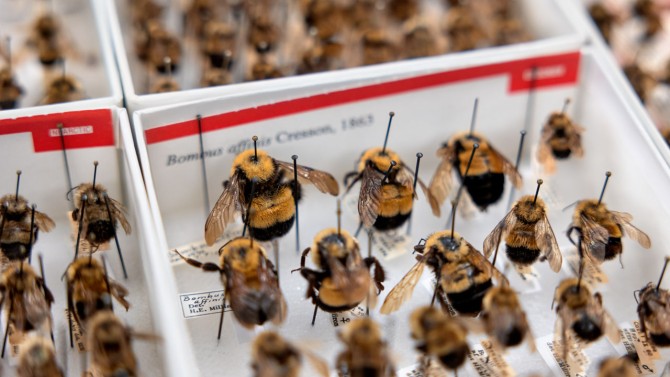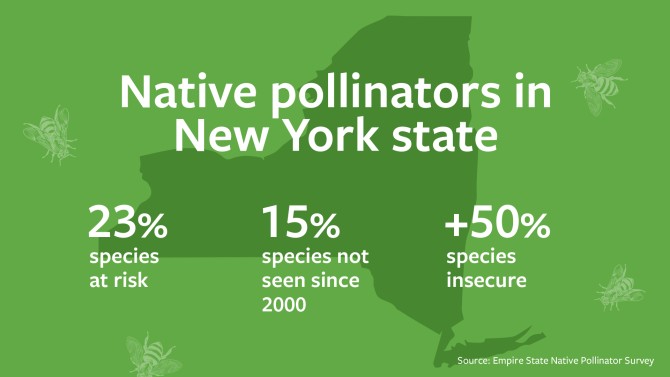Conservation survey finds native NYS pollinators at risk
By James Dean, Cornell Chronicle
A New York state survey, supported by Cornell bee experts, finds that more than half of important native pollinators may be at risk of disappearing from the state – potentially threatening crops, wildflowers and insect diversity.
The three-year Empire State Native Pollinator Survey, released Aug. 4 by the state Department of Environmental Conservation (DEC), found that at least 38% – and as many as 60% – of the pollinators targeted by the survey are at risk because they are rare or declining. For bees, up to 24% of the species may be at risk and an additional 11% are considered possibly extirpated, or known only from historical records. The survey is among the most systematic conservation status assessments of pollinators conducted by any state, according to its authors.
The survey establishes a baseline for future monitoring of wild bees, wasps, flies, beetles and moths that are key pollinators of crops, wildflowers and host plants, and offers recommendations aimed at preserving biodiversity – from habitat conservation to reduced pesticide use.
“There is evidence that there’s really been a dropoff in the abundance of many of these species, and that’s worrisome” said Bryan Danforth, professor in the Department of Entomology in the College of Agriculture and Life Sciences. “A lot of New York state agriculture depends on insect-pollinated crops, so that’s a practical reason to be concerned. And if we lose some of these bees, we will lose a very interesting slice of insect diversity in New York. We could also lose some native wildflowers.”
Danforth’s lab led the survey’s identification of more than 20,000 bee specimens now housed at the Cornell University Insect Collection, one of the largest in North America, with samples dating to the 1860s. Lab manager Maria Van Dyke led the taxonomic effort, supported by a team of trained undergraduates.
Danforth and Van Dyke served on an advisory committee that in 2017 helped design the survey that was managed by the New York Natural Heritage Program, part of the State University of New York’s College of Environmental Science and Forestry, under a contract from the DEC.
The researchers first identified the “focal taxa” they would look for, a representative subset of native pollinators (not including honey bees, which are not native). They then compared historical records, including from Cornell’s collection, with extensive field surveys conducted in meadow, forest, wetland and roadside habitats across the state – about 50 sites each year from 2018 to 2020.
Overall, assisted by citizen scientists who uploaded photos to the iNaturalist platform, the survey assigned NatureServe state conservation status ranks, or “S-ranks,” to 457 species.
Using conservative criteria, less than half of the species were ranked as secure, with 23% designated as at risk and another 15% not seen in New York since 2000. But more typical criteria for determining at-risk species suggested that 60% may be at risk in New York.
“That’s a lot of species that we can’t find in any good numbers in the state, that seem to have disappeared from a lot of their former range or that we can’t find at all despite a pretty significant effort over three years,” said Matthew Schlesinger, chief zoologist for the New York Natural Heritage Program and an author of the survey report. “When we lose species, we lose a part of what makes New York unique.”
While providing the best estimates available, the authors said their methodology could have missed some species, for example by not sampling agricultural habitats.
Surveyors confirmed the absence of the rusty patched bumble bee (Bombus affinis), which the U.S. in 2017 named an endangered species and is believed to no longer be present in New York. They found just a single sample of the red-bellied miner bee (Andrena erythrogaster), which was flagged as seriously in decline.
“This is the kind of thing that we worry about,” Danforth said. “This bee was historically present in New York state, quite common, and it’s now dropped off the radar.”
On the other hand, Danforth and Van Dyke were reassured to find the Hawthorn miner bee (Andrena crataegi), an apple pollinator that seems to be abundant even in non-agricultural habitats. And though they remain rare and at-risk, surveyors collected specimens of all three oil bee species (genus Macropis) that had previously been collected In New York. The bees rely exclusively on oils obtained from yellow loosestrife plants to line their brood cells and provision their offspring.
“While they’re probably not as common as in the past,” Van Dyke said, “isolated populations of these specialized bees can still be found in wetland habitats in New York.”
The survey could prompt policymakers to update lists of endangered and threatened species, protecting habitat for the most vulnerable species. The report highlights various other conservation and land-management practices that could benefit pollinators, including reduced use of pesticides and herbicides; invasive species control; discouraging high densities of honey bee hives that could transmit disease; minimizing light pollution; and more careful roadside mowing and prescribed burns.
“Once we’ve identified species that are in decline,” Danforth said, “we can make recommendations for how to preserve habitats and host plants that are crucial to supporting those native pollinators.”
Get Cornell news delivered right to your inbox.
Subscribe


